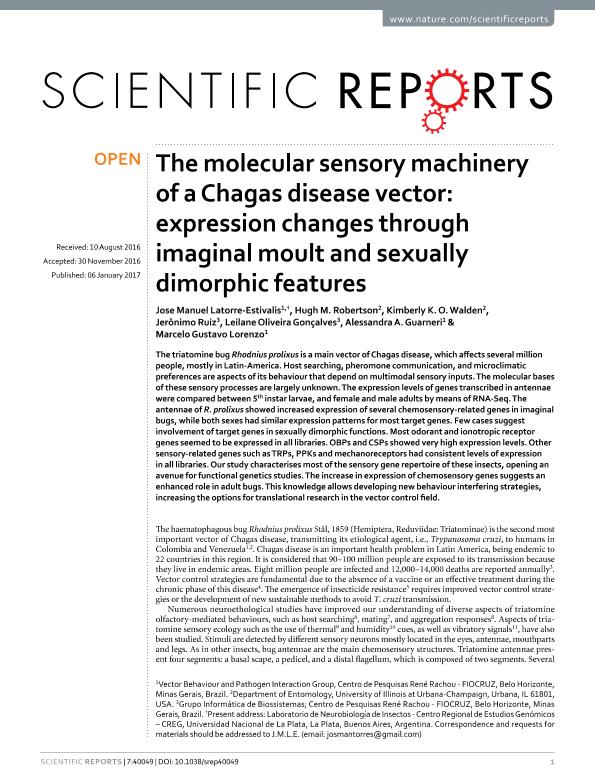Mostrar el registro sencillo del ítem
dc.contributor.author
Latorre Estivalis, Jose Manuel

dc.contributor.author
Robertson, Hugh M.
dc.contributor.author
Walden, Kimberly K. O.
dc.contributor.author
Ruiz, Jerônimo
dc.contributor.author
Oliveira Gonçalves, Leilane
dc.contributor.author
Guarneri, Alessandra Aparecida
dc.contributor.author
Lorenzo, Marcelo Gustavo

dc.date.available
2019-06-12T21:27:03Z
dc.date.issued
2017-01
dc.identifier.citation
Latorre Estivalis, Jose Manuel; Robertson, Hugh M.; Walden, Kimberly K. O.; Ruiz, Jerônimo; Oliveira Gonçalves, Leilane; et al.; The molecular sensory machinery of a Chagas disease vector: Expression changes through imaginal moult and sexually dimorphic features; Nature Publishing Group; Scientific Reports; 7; 1-2017; 1-16
dc.identifier.issn
2045-2322
dc.identifier.uri
http://hdl.handle.net/11336/78155
dc.description.abstract
The triatomine bug Rhodnius prolixus is a main vector of Chagas disease, which affects several million people, mostly in Latin-America. Host searching, pheromone communication, and microclimatic preferences are aspects of its behaviour that depend on multimodal sensory inputs. The molecular bases of these sensory processes are largely unknown. The expression levels of genes transcribed in antennae were compared between 5 th instar larvae, and female and male adults by means of RNA-Seq. The antennae of R. prolixus showed increased expression of several chemosensory-related genes in imaginal bugs, while both sexes had similar expression patterns for most target genes. Few cases suggest involvement of target genes in sexually dimorphic functions. Most odorant and ionotropic receptor genes seemed to be expressed in all libraries. OBPs and CSPs showed very high expression levels. Other sensory-related genes such as TRPs, PPKs and mechanoreceptors had consistent levels of expression in all libraries. Our study characterises most of the sensory gene repertoire of these insects, opening an avenue for functional genetics studies. The increase in expression of chemosensory genes suggests an enhanced role in adult bugs. This knowledge allows developing new behaviour interfering strategies, increasing the options for translational research in the vector control field.
dc.format
application/pdf
dc.language.iso
eng
dc.publisher
Nature Publishing Group

dc.rights
info:eu-repo/semantics/openAccess
dc.rights.uri
https://creativecommons.org/licenses/by/2.5/ar/
dc.subject
Rhodnius Prolixus
dc.subject
Transcriptomica
dc.subject
Receptores Sensoriales
dc.subject.classification
Otras Ciencias Biológicas

dc.subject.classification
Ciencias Biológicas

dc.subject.classification
CIENCIAS NATURALES Y EXACTAS

dc.title
The molecular sensory machinery of a Chagas disease vector: Expression changes through imaginal moult and sexually dimorphic features
dc.type
info:eu-repo/semantics/article
dc.type
info:ar-repo/semantics/artículo
dc.type
info:eu-repo/semantics/publishedVersion
dc.date.updated
2019-05-23T19:12:30Z
dc.journal.volume
7
dc.journal.pagination
1-16
dc.journal.pais
Reino Unido

dc.journal.ciudad
Londres
dc.description.fil
Fil: Latorre Estivalis, Jose Manuel. Consejo Nacional de Investigaciones Científicas y Técnicas. Centro Científico Tecnológico Conicet - La Plata; Argentina. Universidad Nacional de La Plata. Centro Regional de Estudios Genómicos; Argentina. Fundación Oswaldo Cruz; Brasil
dc.description.fil
Fil: Robertson, Hugh M.. University of Illinois at Urbana; Estados Unidos
dc.description.fil
Fil: Walden, Kimberly K. O.. University of Illinois at Urbana; Estados Unidos
dc.description.fil
Fil: Ruiz, Jerônimo. Fundación Oswaldo Cruz; Brasil
dc.description.fil
Fil: Oliveira Gonçalves, Leilane. Fundación Oswaldo Cruz; Brasil
dc.description.fil
Fil: Guarneri, Alessandra Aparecida. Fundación Oswaldo Cruz; Brasil
dc.description.fil
Fil: Lorenzo, Marcelo Gustavo. Fundación Oswaldo Cruz; Brasil
dc.journal.title
Scientific Reports
dc.relation.alternativeid
info:eu-repo/semantics/altIdentifier/url/http://www.nature.com/articles/srep40049
dc.relation.alternativeid
info:eu-repo/semantics/altIdentifier/doi/http://dx.doi.org/10.1038/srep40049
Archivos asociados
